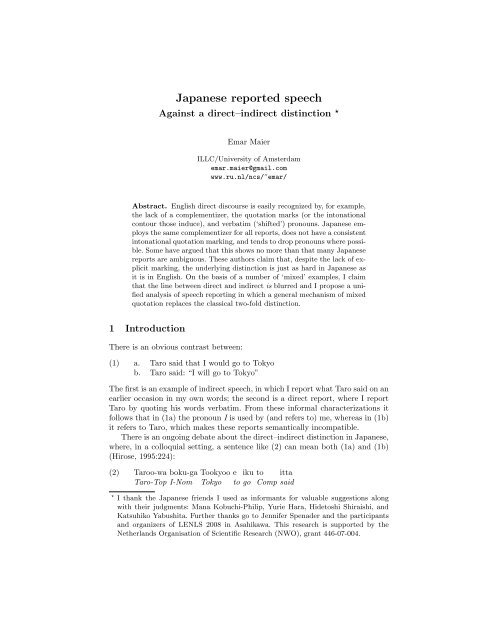Japanese reported speech - UvA DARE
Japanese reported speech - UvA DARE
Japanese reported speech - UvA DARE
- No tags were found...
Create successful ePaper yourself
Turn your PDF publications into a flip-book with our unique Google optimized e-Paper software.
two functions of language: words can be used to refer to the world (use), but alsoto refer to words and other linguistic items (mention). Before arguing against it,let me first clarify the supposed link between indirect–direct and use–mention.3 Modeling the indirect–direct distinction as use vs.mentionModeltheoretically, language use is what’s captured by the familiar Fregeansemantics. A proper analysis of indirect <strong>speech</strong> reporting and indexicality requiresKaplan’s two-dimensional version, which analyzes indirect saying that asan intensional operator. x says that ϕ means that x uttered some sentence thatexpressed the same proposition as that expressed by ϕ in the current reportcontext.Mention requires the addition of a separate expression type (u) and domain(D u ) of utterances to our models (Potts 2004). Mentioning is modeled as an operator , the formal counterpart of (pure) quotation, that turns any utteranceinto a term of type u referring to that utterance. Strictly speaking, D u containsphonetic or alphabetic surface representations of utterances (say, finite stringsof symbols in a finite alphabet). The formal quotational language, QL, consistsof triples containing a linguistic object (∈ D u ) , a semantic type, and a standardlogical representation: 2(6) a. notation: fool’ := 〈fool, et, λx[fool(x)]〉 ∈ QLsemantics: fool’ = the set of fools ⊆ D eb. notation: fool := 〈‘fool’, u, fool〉 ∈ QLsemantics: fool = fool ∈ D uThis logic of mention extends to a straightforward semantics of direct <strong>speech</strong>:Simply analyze ‘say’ in its direct discourse sense as a transitive verb that takesas direct object a term of type u, and analyze quotation marks as mention,capturing the traditional view of direct discourse being a relation between anindividual and an utterance.To summarize, the direct–indirect discourse distinction can be cached outformally in an intensional logic with a mention operator. Indirect discourse sayingtranslates as say id ’, an operator of type (st)et, as in (7a), while direct discoursetranslates as say dd ’, an operator of type uet, as in (7b):(7) a. Taro said I’m going to Tokyo say id ’(taro’)( ∧ go tokyo’(i’))b. Taro said: “I will go to Tokyo” say dd ’(taro’)(I will go to Tokyo)2 The last two slots may be empty, to allow for quotations of <strong>speech</strong> errors, meaninglesssounds or ungrammatical utterances (Maier 2007): misunderestimate ≈〈misunderestimate, eet, −〉, grrr≈ 〈grr, −, −〉.
sentence, i.e. in (15) it’s a property (et). We’ll call this new three place relationrefer. Otherwise, the DRS just represents an indirect report, using the Kaplanianmonster-free say id from section 3 above.More specifically, after some trivial resolutions the DRS representing (15) is:(16)say id (x) :xquine(x)yquotation(y)P(y)Prefer(x, has a certain anomalous feature, P)Now, the remaining presupposition searches the global context for a <strong>speech</strong> eventof Quine uttering the mentioned phrase to bind to. If that fails, an appropriateantecedent will be accommodated. In any case, we get an output DRS as in(17), that states that Quine uttered “has a certain anomalous feature” to referto some property (not otherwise specified), and says (id) that quotation has thatproperty:(17)x Pquine(x)refer(x, has a certain anomalous feature, P)ysay id (x) :quotation(y)P(y)In this way we get an account of the hybrid use/mention character of mixedquotation. The analysis suggests an extension to direct discourse, analyzing itas mixed quotation of an entire sentence (i.e. type t rather than et). This wouldeffectively blur the line between direct and indirect discourse. The following pictureemerges: to report another’s <strong>speech</strong> there is only indirect discourse, withinwhich the device of mixed quotation can be used to mimic a particular phraseof the <strong>reported</strong> <strong>speech</strong> act verbatim. 6 Direct discourse, in this picture, is merelya limiting case of mixed quotation. The aim of the current paper is to presentindependent evidence for this blurring of the direct–indirect distinction.For more details and a comparison with Potts’ (2004) related framework, Irefer the reader to Geurts and Maier (2005) and Maier (2007).6 The reporter can have a variety of reasons for wanting to do this: he may not haveunderstood the original words, the words may be meaningless, the reporter may beuncomfortable using the phrase, may want to liven up his whole report, may considerthat phrase exceptionally well put, etc.
My father screamed that he would never allow me to marry∂[the individual he refers to as that bastard Webster]Anand argues that the quotational shift analysis of ‘non-speaker-oriented expressives’is empirically superior to Potts’ analysis that meddles with the Kaplan’scontexts by adding a ‘expressive judge’ parameter.I claim that in both cases of shiftiness in reports the mixed quotation analysisis simpler and more compatible with tried and tested semantic theory than thealternatives: Schlenker’s monsters, which overturn Kaplan’s famous prohibitionthereof and even threaten the notion of rigidity, 9 in the case of Amharic shiftedI; and the ad hoc addition of shiftable expressive judges to the utterance context(cf. Anand 2007), in the case of expressive shift.5.3 Mixed quotation in <strong>Japanese</strong> and beyondMy analysis of the <strong>Japanese</strong> data is now easily stated. The examples in 4.2appear to mix direct and indirect discourse because they do; they are indirectreports with a mixed quoted phrase. Let’s go through a couple of our examples.The intended ‘indirect’ reading (8b) of (8), the report with the embedded-masu form, corresponds to a logical form where that form (and perhaps somemore, but not the first person pronoun) is mixed quoted:(21) kare wa watashi ga “matta machigaimashita” to iimashitahe Top I Nom again was.wrong-Polite Comp said-Polite≈ ‘He said that I was “wrong again”’ 10 [ ]cf. (8) he said that I was ∂[what he referred to as wrong again]Note again that this involves quotation marks that are invisible on the surface. Ihave defended this assumption for Amharic briefly above. In fact, I share it withdirect–indirect separatists like Coulmas, who appeals to them to get the otherreading, (8a). For us, that so-called direct discourse reading brings nothing new,the only difference with (21) is that the first person pronoun is now also part ofthe mixed quote, which presumably now covers the whole clause:(22) He said that “I was wrong again”The next two examples, (10) and (12), feature (invisible) mixed quoted imperatives:9 Schlenker argues that his system upholds Kaplan’s fundamental distinction betweenrigid/directly referential and descriptive terms, but this is much less clear in e.g.Von Stechow’s (2002) related account where shifted indexicals correspond to merebound variables.10 My English translation’s quotation does not include the was, which is included in the<strong>Japanese</strong> version. In English it would sound strange to include the auxiliary becauseof the clash of third vs. first person inflection. Note also that the inclusion of thepast tense morpheme in both <strong>Japanese</strong> and English is not theoretically necessary;the theory predicts that it should also be possible to mix-quote just the politenessmorpheme, for instance.
(23) ashita made nitomorrow untilsonothatshigoto-o “yare” to jooshi-niwork-Acc do-Imp Comp boss-byiwaremashitawas told-Polite≈ ‘I was told by the boss that I should “finish!” that work by tomorrow’[cf. (10)]The quotation marks correctly defer the impolite imperative force to the <strong>reported</strong>speaker, the boss. 11To get a fully unified account of shifting through mixed quotation, the logicalform of (13), finally, requires mixed quotation of iku (‘go’), which yields theinterpretation Matsushima said he would do ∂[what he referred to as go] tomy house. And similarly for (14). Of course, on the basis of only these particularexamples we cannot discard the possibility that iku and yaru are simply descriptiveterms that can be freely shifted by binding to any salient reference point. Todecide between these alternative analyses, shifting by quotation or by binding,the behavior of the predicates in non-report clauses is crucial: if they can shifttheir reference point there as well the predicate is not truly context-oriented andquotation is not needed. If shifts occur only in reports, however, the by nowproperly motivated mixed quotation mechanism can take care of the perspectiveshifting without added semantic machinery. To determine which way to go withthe predicates at hand more empirical research is required.I have provided a principled account of shifting without complicating ourcontexts or the semantics of indexicals and reports. We have essentially given upthe two-fold direct–indirect distinction. In fact, we have given up the whole notionof direct discourse: <strong>speech</strong> reporting follows Kaplan’s semantics of indirectdiscourse except for the parts (in some cases the whole clause, or more) that aremixed quoted. These quoted parts are automatically (by presupposition resolution)deferred to the <strong>reported</strong> speaker. For <strong>Japanese</strong> in particular, this meanswe can keep the intuitive analysis of speaker/addressee-oriented expressions asindexicals, so that indeed in <strong>reported</strong> <strong>speech</strong> “addressee-oriented expressions are,by definition, used only as public expressions [= direct discourse/quotation].”What we reject is the, often implicit, assumption that “phrases and sentencescontaining addressee-oriented expressions are also adressee-oriented, functioningas public expression [= direct discourse].” (Hirose 1995:227)ReferencesAbbott, B.: Some notes on quotation. In de Brabanter, P., ed.: Hybrid Quotations.Volume 17 of Belgian Journal of Linguistics. John Benjamins (2005) 13–26Anand, P., Nevins, A.: Shifty operators in changing contexts. In Young, R., ed.:Proceedings of SALT XIV, Cornell, NY, CLC (2004)Anand, P.: Re-expressing judgment. Theoretical Linguistics 33 (2007) 199–20811 Spelling out the whole story here requires that we settle on a proper semantics ofimperatives, a rather tricky but independent problem that I cannot go into here.
Cappelen, H., Lepore, E.: The varieties of quotation. Mind 106 (1997) 429–50Coulmas, F.: Direct and indirect <strong>speech</strong>: general problems and problems of <strong>Japanese</strong>.Journal of Pragmatic 9 (1985) 41–63Geurts, B., Maier, E.: Quotation in context. In de Brabanter, P., ed.: Hybrid Quotations.Volume 17 of Belgian Journal of Linguistics. John Benjamins (2005) 109–28Hirose, Y.: Direct and indirect <strong>speech</strong> as quotations of public and private expression.Lingua 95 (1995) 223–238Kaplan, D.: Demonstratives. In Almog, J., Perry, J., and Wettstein, H. eds.: Themesfrom Kaplan, New York, Oxford University Press (1989) 481–614Kratzer, A.: Beyond ouch and oops: How descriptive and expressive meaning interact(1999) Cornell Conference on Theories of Context Dependence.Kuno, S.: Blended quasi-direct discourse in <strong>Japanese</strong>. In Poser, W., ed.: Papers fromthe Second International Workshop on <strong>Japanese</strong> Syntax, Stanford, CSLI (1988)75–102Maier, E.: Mixed quotation: between use and mention. In: Proceedings of LENLS2007, Miyazaki, Japan (2007)Maier, E.: Quotation marks as monsters, or the other way around? In Aloni, M.,Dekker, P., Roelofsen, F., eds.: Proceedings of the Sixteenth Amsterdam Colloquium,Amsterdam, ILLC (2007) 145–150Oshima, D.: Perspectives in Reported Discourse. PhD thesis, Stanford (2006)Potts, C., Kawahara, S.: <strong>Japanese</strong> honorifics as emotive definite descriptions. In Watanabe,K., Young, R.B., eds.: Proceedings of the 14th Conference on Semantics andLinguistic Theory. CLC Publications, Ithaca, NY (2004) 235–254Potts, C.: Lexicalized intonational meaning. In Kawahara, S., ed.: University of MassachusettsOccasional Papers 30. GLSA, Amherst, MA (2005)Potts, C.: The dimensions of quotation. In Barker, C., Jacobson, P., eds.: DirectCompositionality. Oxford University Press (2007) 405–431Schlenker, P.: A plea for monsters. Linguistics and Philosophy 26 (2003) 29–120von Stechow, A.: Binding by verbs: Tense, person and mood under attitudes. InKadowaki, M., Kawahara, S., eds.: Proceedings of NELS 33. GLSA, Amherst, MA(2002) 379–403














